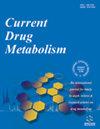油菜醛反应中心的理论评估
IF 2.1
4区 医学
Q4 BIOCHEMISTRY & MOLECULAR BIOLOGY
引用次数: 0
摘要
背景::癸羧甲基ligstroside aglycone(油黄质)是橄榄油中的一种重要成分。因此,研究它在人体内的新陈代谢很有意义。为了找到这种新陈代谢的最佳起点,我们利用 DFT 计算和对接研究进行了理论研究。研究方法利用 DFT、B3LYP/6-311++G** 和 PCM 溶解模型计算研究了 CYP1A2 酶代谢油菜醛的初始过程。获得了油菜醛结构中氢原子同解形成的自由基结构,并研究了它们的性质。研究考虑了可能的油菜素自由基的 HOMO 和 LUMO 能隙、键解离能 (BDE)、硬度和自旋密度等参数。此外,还将油菜醛与酶结合口袋进行了对接,以确定最可能的代谢位点。通过对理论结果的详细分析,可以确定油菜醛最可能的反应位点。此外,还预测了油菜醛与 CYP1A2 酶的结合模式。结果分子对接研究的结果与计算的量子参数一致。理论预测结果与科学文献中的实验数据进行了比较。结果表明,理论计算结果与实验数据高度相关。确定了最有可能的油菜醛代谢位点。结论我们的研究结果支持理论计算在预测代谢途径方面的实用性。本文章由计算机程序翻译,如有差异,请以英文原文为准。
Theoretical Evaluation of Oleocanthal Reactive Centers
Background:: Decarboxymethyl ligstroside aglycone (oleocanthal) is an essential component of olive oil. It is therefore interesting to study its metabolism in the human body. In order to find the best possible starting point for this metabolism, a theoretical study was carried out using DFT calculations and docking studies. Methods:: The DFT, B3LYP/6-311++G** and the PCM solvation model calculations were used to study the initial process of oleocanthal metabolism by the CYP1A2 enzyme. Structures of radicals formed by homolytic dissociation of hydrogen atoms from the oleocanthal structure were obtained and their properties were studied. Several parameters such as HOMO and LUMO energy gaps, Bond Dissociation Energy (BDE), hardness, and spin density of possible oleocanthal radicals were taken into account. Docking of oleocanthal into an enzyme binding pocket was also performed to locate the most probably metabolic site. Detailed analysis of the theoretical results allows the determination of the most likely reaction sites in oleocanthal. The mode of binding of oleocanthal to the CYP1A2 enzyme was also predicted. Results:: The results of the molecular docking studies are in agreement with the calculated quantum parameters. The theoretical predictions were compared with experimental data available in the scientific literature. A high correlation between theoretical calculations and experimental data was observed. The most likely site of oleocanthal metabolism was identified. Conclusion:: The results of our research support the usefulness of theoretical calculations in predicting metabolic pathways.
求助全文
通过发布文献求助,成功后即可免费获取论文全文。
去求助
来源期刊

Current drug metabolism
医学-生化与分子生物学
CiteScore
4.30
自引率
4.30%
发文量
81
审稿时长
4-8 weeks
期刊介绍:
Current Drug Metabolism aims to cover all the latest and outstanding developments in drug metabolism, pharmacokinetics, and drug disposition. The journal serves as an international forum for the publication of full-length/mini review, research articles and guest edited issues in drug metabolism. Current Drug Metabolism is an essential journal for academic, clinical, government and pharmaceutical scientists who wish to be kept informed and up-to-date with the most important developments. The journal covers the following general topic areas: pharmaceutics, pharmacokinetics, toxicology, and most importantly drug metabolism.
More specifically, in vitro and in vivo drug metabolism of phase I and phase II enzymes or metabolic pathways; drug-drug interactions and enzyme kinetics; pharmacokinetics, pharmacokinetic-pharmacodynamic modeling, and toxicokinetics; interspecies differences in metabolism or pharmacokinetics, species scaling and extrapolations; drug transporters; target organ toxicity and interindividual variability in drug exposure-response; extrahepatic metabolism; bioactivation, reactive metabolites, and developments for the identification of drug metabolites. Preclinical and clinical reviews describing the drug metabolism and pharmacokinetics of marketed drugs or drug classes.
 求助内容:
求助内容: 应助结果提醒方式:
应助结果提醒方式:


